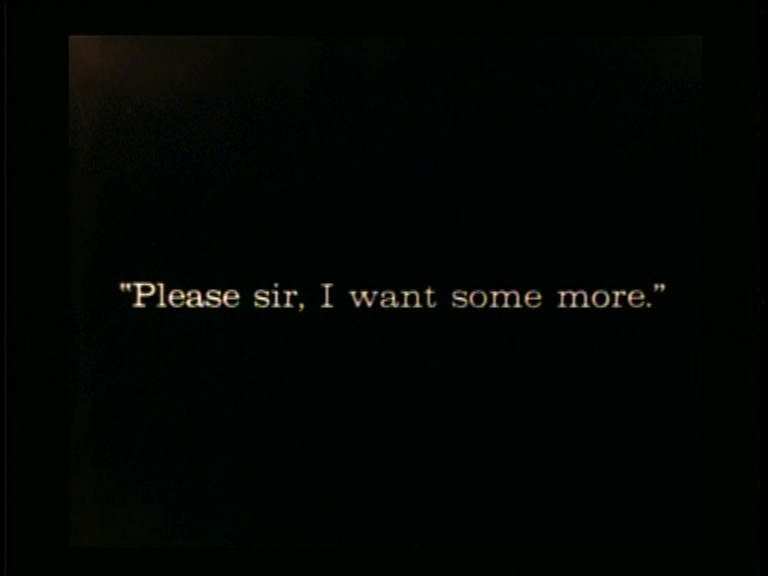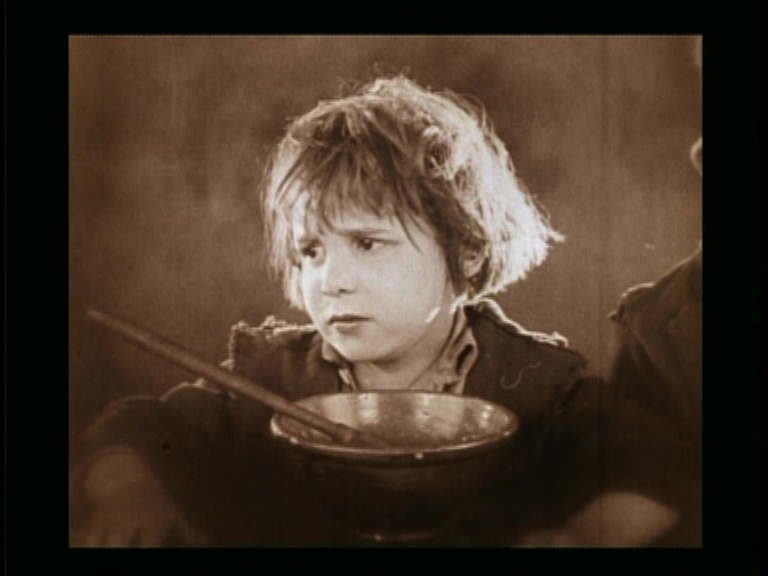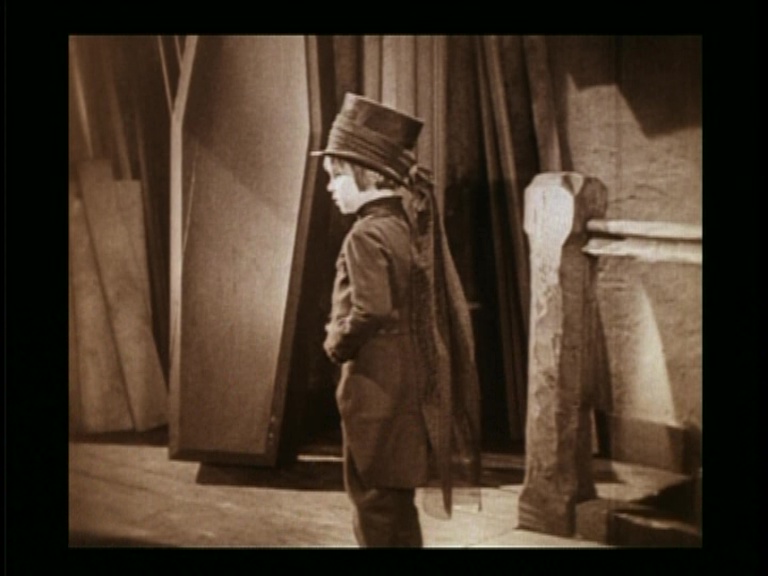This prestige adaptation of Dickens’ famous novel was designed as a vehicle for top child star Jackie Coogan and featured some of the top talent found in silent era Hollywood, including director Frank Lloyd and co-star Lon Chaney.
Home Media Availability: Released on DVD.
“Oliver Twist has asked for more!”
Oliver Twist is part of the Dickens pantheon and even people who have never cracked a Victorian volume in their lives are familiar with the “Please, sir, I want some more” scene. It’s the story of an orphan boy whose mother died in childbirth. Starved in the workhouse, Oliver is chosen to ask for more gruel on behalf of the other boys and is punished for his greed and audacity. (The novel is a broad satire of the “mercies” shown to the impoverished and, frankly, is more timely than every.)
After some misadventures as the assistant to a mortician, Oliver runs away to London and falls in with the Artful Dodger, a charismatic child thief, and his boss, Fagin. He also meets a burglar named Sykes and a prostitute named Nancy. After realizing that his new friends are on the wrong side of the law, Oliver spends the rest of the book trying to escape them, all the while, his mysterious past is threatening to come to light…
The 1922 adaptation was by no means the first Oliver Twist movie. The 1909 Vitagraph production was a highly abridged version of the story (with Nancy restyled “Nancy Sykes” to add respectability) and the 1916 Paramount adaptation starred Marie Doro as Oliver (trouser role casting was extremely common). A shame it’s lost as I would dearly love to see Hobart Bosworth as Sykes, Tully Marshall as Fagin and Raymond Hatton as the Artful Dodger.
The 1922 version of Oliver Twist was mindfully staffed. Director Frank Lloyd had already successfully tackled Dickens in the Fox prestige production of A Tale of Two Cities. Jackie Coogan was hot off his success in Charlie Chaplin’s The Kid and had been signed by Sol Lesser with Peck’s Bad Boy being released around the same time as Oliver Twist. Lon Chaney had built his reputation as a villain and a master of makeup. George Siegmann’s burly build and talent for menace made him a good choice for Sykes.
The film opens with a highly abridged and rewritten version of Dickens’ preface to the third edition of the book and then gets right down to business. (By the way, Oliver Twist was recovered sans title cards, which had to be recreated with the help of the original crew.) Oliver is born, his mother passes and then we are shown his life in the workhouse. The workers are starved and the young boys decide that one of them must ask for a larger portion of gruel. Oliver draws the unfortunate lot and is deemed a troublemaker and sent away to apprentice to an undertaker, Mr. Sowerberry (Nelson McDowell).
The film unfolds along the lines of the novel, with one major change being the early introduction of the locket worn by Oliver’s mother and the character of Mr. Monks (Carl Stockdale), a cryptic figure who seems inexplicably obsessed with our young hero. These elements are taken directly from the novel but were introduced much later in print, while the screen adaptation has them running parallel to the main action with Oliver and the Fagin gang. This more modern plotting streamlines the story considerably, though the lumbering narrative is something of a Dickens trademark and not really a flaw in my eyes.
While Jackie Coogan received the majority of the acting kudos in 1922 and Lon Chaney’s modern popularity has assured his acclaim in this picture, Gladys Brockwell’s turn as the tragic Nancy is quite excellent. She is, perhaps, not as saucy as the Nancy of the novel but Brockwell does a lovely job portraying the compassion and terror intrinsic to the character.
The scale of Oliver Twist is not quite as enormous as Lloyd’s A Tale of Two Cities but the production design and cinematography are suitably moody, if only slightly larger than the earlier Vitagraph production. Of course, this claustrophobic feel may also be due to the fact that most of the action takes place in dark hideouts and a dreary workhouse.
When discussing Oliver Twist, the issue of Fagin is, well, a lot but we’re going to face the topic head-on. The character was so iconic that “fagin” entered the English language as a noun to describe a criminal who instructs other criminals. Fagin was also the only Jewish character in Oliver Twist and one of the few in Dickens’ body of work.
In addition to descriptions that played into known Jewish stereotypes, Fagin is referred to as “the Jew” nearly 400 times (not a typo) in Oliver Twist and no other character in the book is identified by their cultural/religious background or ethnicity in such a way. When not called by their names, they are referred to by their gender/age (boy), their social class (gentleman), their profession (beadle), and so forth. There’s no “the Yorkshireman” or “the Irishwoman” or “the Catholic” to be found.
As is very often the case when dealing with charges of racism or prejudice against famous dead people, their defenders will twist themselves into rhetorical pretzels to explain why they could not possibly really have meant all the things they wrote, filmed, painted, etc.
Well, I am going to cut the knot: Charles Dickens absorbed the antisemitic prejudices that were commonplace in nineteenth century England (and, in fact, Europe in general) and incorporated them into the character of Fagin. To deny that displays naivete that is not really worth my time to engage with. If I referred to an acquaintance as “the redhead” 400 times while making no reference to the hair color of anybody else, people would rightly suppose that I had strong feelings about gingers. This isn’t rocket science.
When the Davis family, who were Jewish, purchased Dickens’ home, Eliza Davis took the acquaintance as an opportunity to address the subject of Fagin, pointing out that Jewish people were endangered by such villainous portrayals. At first, Dickens denied all charges of antisemitism. However, he cut down his obsessive use of the term “the Jew” to refer to Fagin in later editions of Oliver Twist (though the references still number into the hundreds) and introduced a kindly Jewish character in his then-current novel, Our Mutual Friend.
Clearly, Davis struck a nerve and reading over his own material seems to have been eye-opening for Dickens. The question of whether he did enough, especially since Fagin was so intrinsically associated with his ethnicity by the time the author saw the light, is a different debate for a different time.
The 1922 production followed Dickens’ own lead. Fagin is not referred to by his ethnicity at all in the restored title cards, nor in the studio’s marketing material. In fact, while Lon Chaney’s makeup skills were praised, the marketing only had eyes for Jackie Coogan. That’s hardly surprising as Coogan had been signed by producer Sol Lesser, while Chaney was hired especially for the role of Fagin. Still, Chaney’s performance was informed by theatrical traditions and generations of book illustrations and relied on stereotypes that were, at times, cringe-inducing. (Chaney also fell into this when portraying Chinese characters.)
In response to the film’s release, The American Jewish World republished the correspondence between Eliza Davis and Charles Dickens. (Editorial remarks sided with Dickens.) Coverage of the film generally praised both the production values and Coogan’s performance while staying far, far away from the elephant in the room, though several newspapers emphatically referred to Lon Chaney’s character as “Fagin, the Jew.”
The marketing for Oliver Twist did not just rely on good reviews and star power. There were tie-ins, lines of Jackie Coogan-branded clothing and toys, as well as outright gimmicks. One of these stunts involved Coogan reading the intertitles of the film via radio and the sound of his voice would coincide with the titles on the screen in a Los Angeles theater. “To introduce talking pictures” was the boastful headline, though it seems that this fussy method was not a success as it did not gain national traction.
This 1922 version of Oliver Twist is very much a streamlined, Americanized version of the original novel. It’s as smooth and polished as you could wish but I couldn’t help but wish for a few of the Dickens rough edges and bloated scope to remain intact. Still, as a vehicle for Jackie Coogan, it succeeds brilliantly and it neatly showcases what popular entertainment in the 1920s looked like.
Where can I see it?
Released on DVD by Image and as part of the Dickens Before Sound set from the BFI.
☙❦❧
Like what you’re reading? Please consider sponsoring me on Patreon. All patrons will get early previews of upcoming features, exclusive polls and other goodies.
Disclosure: Some links included in this post may be affiliate links to products sold by Amazon and as an Amazon Associate I earn from qualifying purchases.










A well-written and insightful review, as usual.
As a Jewish-raised atheist who unintentionally wrote a book (soon to be in handsome hardback) about his Jewish forebears and upbringing, I appreciate your directness in tackling Dickens’ osmotic Anti-Semitism, for which I forgive him. He was a product of his time, and anti-x-ism is often so ingrained as to be nearly invisible. Plus, he did eventually make some effort to address it. From my nearly-2022 perspective, that suffices.
It is a key tenet of “interrogating memory” that we address the past with honesty, humility and respect – real people are far messier and complicated than our comforting caricatures. You do that well here. We cannot judge history by modernity – well, not entirely, anyway. George Washington was no less brilliant a president because he owned slaves, and…well, you get the idea. 🙂
Thank you! Yes, it’s important to look at how someone was viewed from every angle and the negative Jewish response to Fagin during Dickens’ own lifetime always needs to be part of the conversation, as does his response and his attempts to make amends.
The process of recruiting young people into crime by grooming them, using people of their own peer-group, is as prevelant today as in the past!
Much of Oliver Twist could be set today without many changes, alas. Domestic violence, charity without mercy, etc.